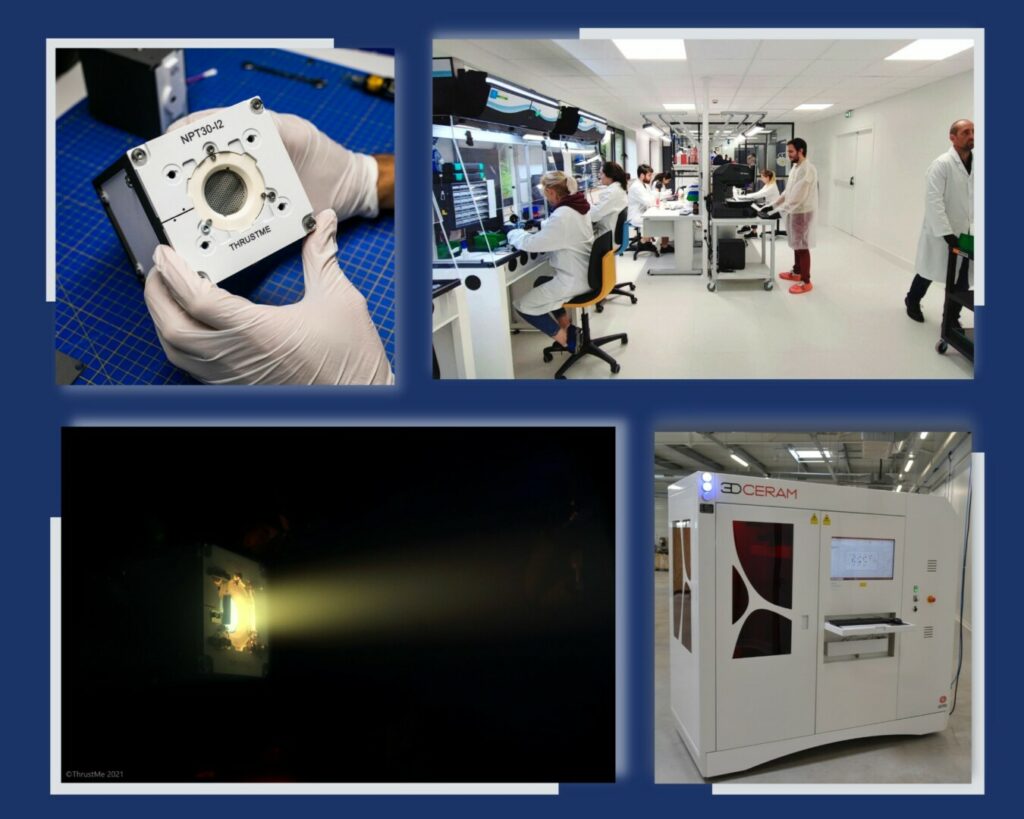PRESS RELEASE JUNE 2023

3DCeram has been selected as one of the suppliers of ThrustMe, a leading New Space company with remarkable achievements in space propulsion. In 2020, ThrustMe successfully made the world’s first demonstration of an iodine-fueled electric propulsion system in space. Today delivering to major satellite constellations, ThrustMe has a new production facility with the capability to produce 365 products per year, and its products comply with the stringent requirements of the space industry.
ThrustMe recognized the immense potential of ceramic materials and turned to 3DCeram for their expertise in additive manufacturing. The 3D-printed ceramics approach aimed to overcome the limitations of traditional manufacturing techniques and materials, offering a more compact, efficient, and reliable solution.
We asked Elena Zorzolli Rossi, ThrustMe product manager, a few questions about ThrustMe’s choice of 3D printing technology and ceramic material.
What led your company to choose 3D printing for manufacturing a specific part? Can you share the thought process that led to the decision to adopt 3D printing technology for what benefits?
The decision to adopt 3D printing technology for manufacturing a specific part in our thruster was driven by a number of factors that emerged from an extensive research process. Primarily, the space industry often requires the production of complex shapes that cannot be easily obtained through traditional machining methods. At ThrustMe, we don't talk about only the complexity but also the miniaturization, a critical requirement in the development of our products. In such cases, 3D printing offers a transformative solution by enabling the creation of specific designs with the precision we need.
Moreover, the versatility of 3D printing technology allows us to swiftly iterate and refine designs without incurring significant costs or lead times. Traditional manufacturing processes often involve the creation of moulds or tooling, which can be time-consuming and expensive. With 3D printing, we can rapidly produce prototypes and iterate on designs with minimal setup time, facilitating a more agile development process and accelerating our time to market.
Before selecting ceramic as the material for your component, did you evaluate other materials, and if so, what factors influenced your decision to ultimately choose ceramic? Was it based on specific properties, environmental considerations, or other reasons?
In the process of selecting the material for our components, several factors were thoroughly evaluated before choosing ceramic. The decision was guided taking into account multiple crucial factors related to the harsh space environment like vacuum and extreme temperature ranges, and specific features of the iodine plasma propulsion system such as energetic fluxes of elementary particles, secondary emission, intense sputtering and reactive ion etching.
The main consideration that influenced our choice was the operating conditions our products encounter. Some of our components are exposed to high temperatures in a chemically active plasma environment, requiring a material with exceptional heat and chemical resistance. Ceramics emerged as the most suitable option in this regard, with its remarkable thermal and chemical stability.
Another vital characteristic that weighed heavily in favour of ceramic was its wide range of thermal conductivity. The efficient transfer or isolation of heat is crucial in our components, as it helps to guide the thermal fluxes effectively and prevent overheating or overcooling. Ceramic materials exhibit an excellent range of conductivity properties, enabling selective heat transfer and ensuring optimal performance in our products.
Additionally, the electric properties of ceramic played a significant role in our material selection process. Our components require a material that can effectively isolate and protect against high-voltage electrical breakdowns. Ceramics possess exceptional electrical isolation properties, making it an ideal choice to meet our stringent requirements in this aspect.
In a broader context, could you discuss the significance of the "New Space" era, its challenges, and its future prospects?
The "New Space" era refers to the recent developments and advancements in the space industry, driven by private companies. This era is characterized by increased commercialization and innovation, as well as a shift away from the traditional dominance of government agencies in space exploration and utilization.
One of the main driving forces behind the New Space era is the rapid advancement of technology. The companies need to take more risks, iterate quickly, and experiment with new ideas, leading to breakthroughs in areas such as satellite technology, space tourism, and even interplanetary exploration. Looking a little closer, it is not only the internal structure and organization that needs to be rethought compared to the more traditional industry. The whole production chain needs to be prepared to meet New Space costs or lead times.
Looking ahead, the future prospects of the New Space era are promising. The ongoing development of technological advancements will continue to drive down the cost of space access and enable more ambitious missions. Accelerating innovation, we are advancing our understanding of the cosmos and improving life on Earth.
| “On 3DCeram side, we take pride in our collaboration with Thrust Me as 3D-printed ceramic components have been successfully sent into space, marking a significant milestone in the application of additive manufacturing. We believe that this successful deployment of 3D-printed ceramic components in space serves as a testament to the immense potential of additive manufacturing. It signifies a new era where complex and customized parts can be efficiently produced, surpassing traditional manufacturing limitations.We believe that sharing this milestone achievement provides a great example of the real-world applications of 3D printing. This significant step forward not only validates the viability of 3D printing as a production tool but also inspires us to reach further and unlock the vast possibilities that lie ahead.” Arnaud Roux – sales representative of 3DCeram |
PRESS CONTACT
3DCERAM: Kareen Malsallez – kareen.malsallez@3dceram.com - +33 (0) 787 038 641
THRUSTME: Fernanda Pimenta Cyrne – press@thrustme.fr